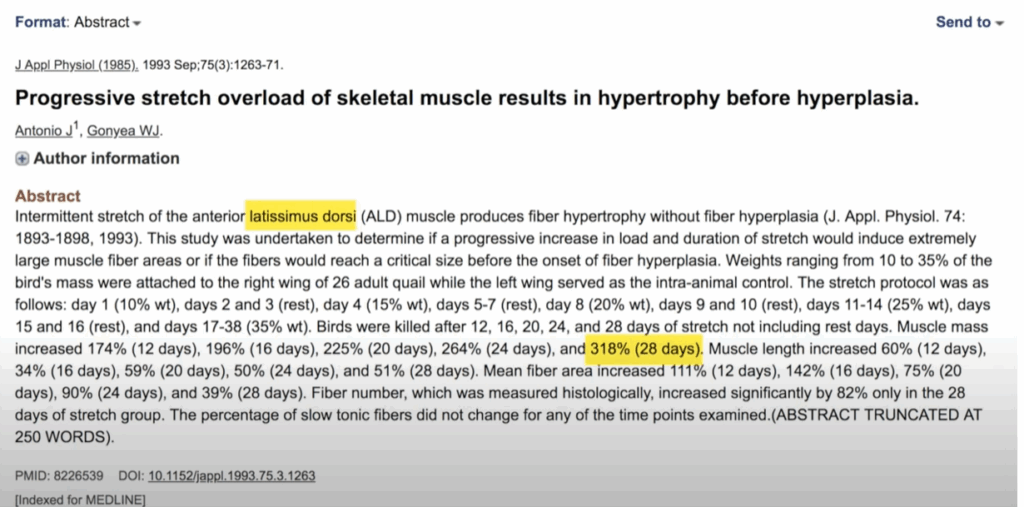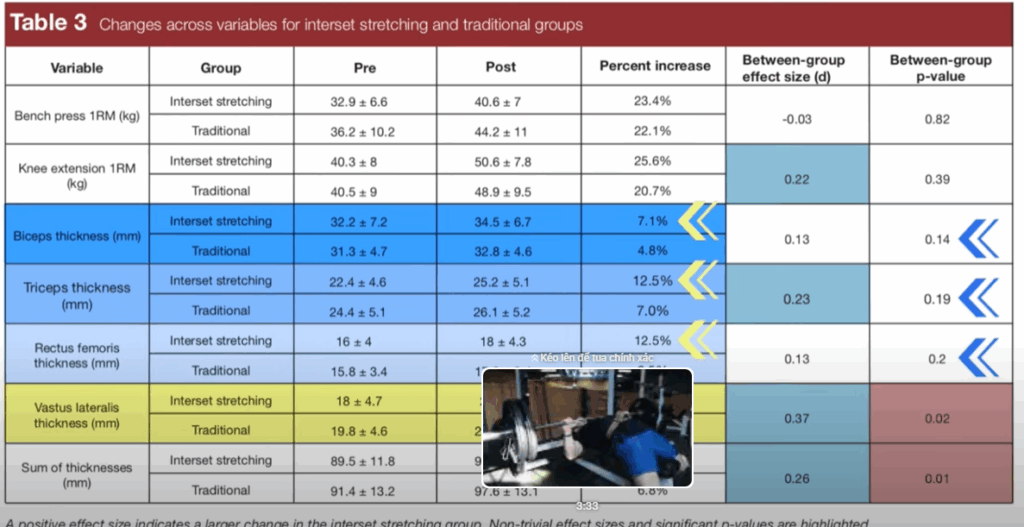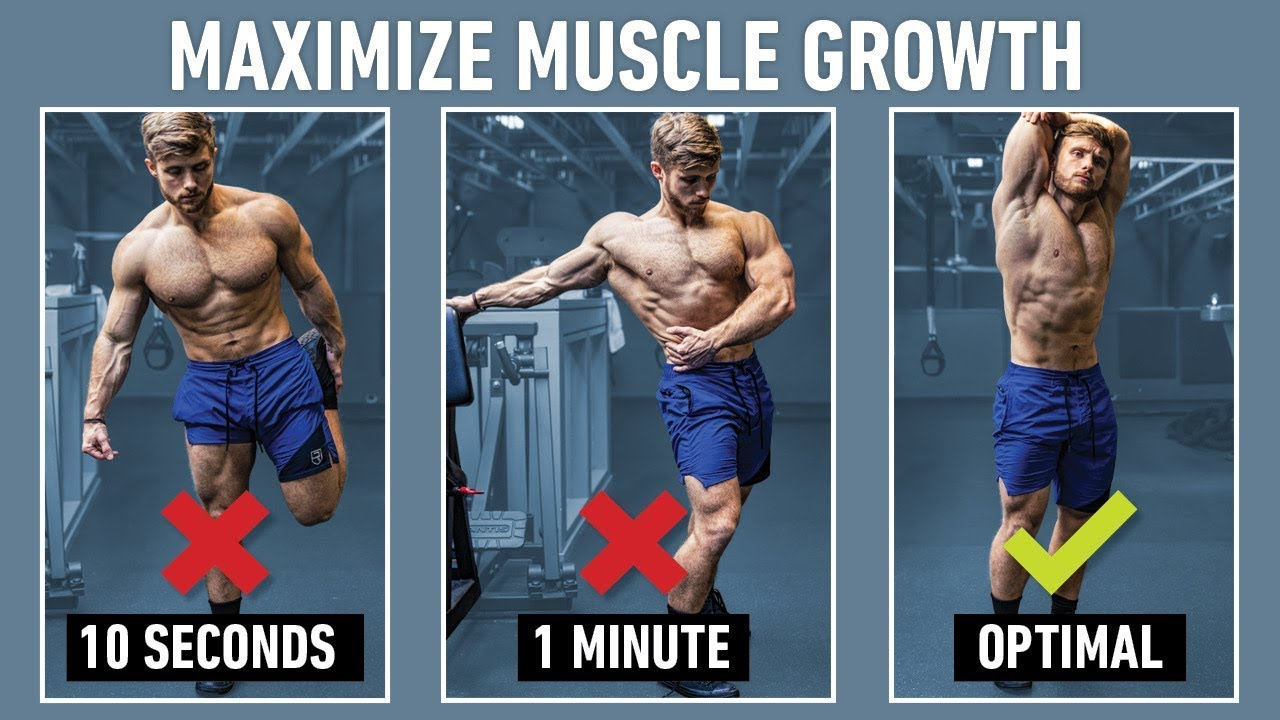For years, the idea of stretching a muscle between sets has been dismissed as “bro science.” Many lifters believed that filling a muscle with blood and then holding it in a stretched position might enhance growth, but there was little evidence to support it—until recently. Emerging research has challenged that skepticism, suggesting that interset stretching (stretching between sets) could provide a noticeable hypertrophy boost when done correctly.
Let’s break down what the latest science actually says, how to apply it in your training, and what precautions you need to take to avoid killing your gains.
The Science Behind Interset Stretching
Early Claims and Myths
The idea that stretching could increase muscle growth isn’t new. In fact, a 1993 animal study reported an astonishing 300% increase in muscle size in the lats of quail after 28 days of weighted stretching. Not surprisingly, this result became a sensational headline in bodybuilding magazines. However, the excitement quickly faded—these findings were in birds, not humans, and no comparable human study replicated the result.
Years later, an unpublished abstract circulated online, claiming that 30-second calf stretches between sets of calf raises led to significant calf growth. But with no official publication, the evidence remained speculative, keeping most experts skeptical.

The Study That Changed Everything
In 2009, a well-designed Brazilian study finally put this concept to the test. Researchers divided 29 participants into two groups:
- Standard Training Group – Performed a full-body routine twice a week (bench press, triceps extensions, seated rows, biceps curls, leg extensions, and leg curls), 4 sets of 8–12 reps to failure.
- Stretching Group – Followed the same workout but added 30-second static stretches of the target muscle between every set.
Participants held the stretch just below the threshold of pain, ensuring it was intense but not unbearable.
Results After 8 Weeks
After two months, researchers measured muscle thickness across four different muscles. The findings were intriguing:
- Overall Growth: The stretching group experienced nearly 50% more total muscle growth than the non-stretching group.
- Most Significant Gains: The vastus lateralis (outer quad) showed statistically significant hypertrophy.
- Other Muscles: Biceps, triceps, and rectus femoris growth also favored the stretching group, but the differences weren’t statistically significant—possibly due to the small sample size or short study duration.
This suggests that while interset stretching might work for all muscles, it may be more effective for larger lower-body muscles like the quads.
How to Use Interset Stretching for Maximum Growth
If you’re already resting 1–3 minutes between sets, adding stretching is an easy way to enhance your session. Here’s how to do it effectively:
1. Keep Intensity Moderate
Stretching should feel challenging but not painful. Studies show that stretching to the point of pain can reduce hypertrophy instead of enhancing it. Aim for a stretch that reaches mild to moderate discomfort.
2. Limit Stretch Duration
Hold each stretch for 30 seconds or less. Longer stretches (over 60 seconds) can temporarily reduce force and power output, negatively affecting performance in subsequent sets.
3. Stretch Only the Target Muscle
Focus on the muscle you’re training in that set. For example:
- Bench press → stretch the pecs between sets.
- Pull-ups → stretch the lats.
- Leg extensions → stretch the quads.
4. Use It Selectively
You don’t need to stretch after every single isolation exercise. Stick to compound or heavy lifts where the growth potential is highest. For example, stretch your chest after bench press but skip it after cable flyes.
5. Avoid Overdoing It
While research is promising, we don’t yet know the upper limit of effective volume. Too much stretching might reduce performance or even increase recovery time. Start conservatively—stretch only during your first 3–4 heavy sets per muscle group.

Why Does It Work?
The exact mechanism isn’t fully understood, but there are a few plausible theories:
- Increased Mechanical Tension – Stretching under load may increase the time the muscle spends under tension, a key driver of hypertrophy.
- Enhanced Blood Flow & Nutrient Delivery – Similar to blood flow restriction (BFR) training, interset stretching may trap blood in the muscle, improving nutrient delivery and cell swelling, which has been linked to muscle growth.
- Greater Fiber Recruitment – The prolonged stretch might help activate stubborn muscle fibers that aren’t fully recruited during standard lifting.
More research is needed, but even without a fully confirmed mechanism, the practical results are promising.
Who Should Try Interset Stretching?
This technique may be especially beneficial for:
- Bodybuilders and physique athletes aiming to maximize hypertrophy.
- Lifters with lagging body parts (e.g., stubborn calves or quads).
- Intermediate and advanced trainees who already follow a solid program and need an additional growth stimulus.
For beginners, simply focusing on proper form and progressive overload is likely a better starting point.
Sample Application
Here’s how you might include interset stretching in a typical push day:
- Bench Press (4×8–10) – Stretch chest for 30 seconds between sets.
- Overhead Press (3×8–10) – Stretch shoulders between sets.
- Triceps Dips (3×10–12) – Stretch triceps only during the first 2–3 sets.
- Chest Flyes & Triceps Pushdowns – No stretching required.
You can apply similar logic to other training days.
Common Mistakes to Avoid
- Stretching Too Hard – Going beyond mild discomfort can reduce performance and even interfere with recovery.
- Holding Stretches Too Long – More than 30 seconds may decrease strength output for the next set.
- Stretching Every Exercise – Focus on compound lifts rather than burning time between isolation sets.
- Using It as a Warm-Up – Interset stretching is not a replacement for dynamic warm-ups. Use dynamic mobility work pre-workout, and save static stretching for between sets or
- after training.

Should You Start Today?
While more long-term studies are needed, the current evidence suggests that interset stretching is a low-risk, potentially high-reward strategy. If done with proper intensity and duration, it could give you an edge, especially for stubborn muscle groups.
Think of it as an add-on strategy, not a replacement for progressive overload, good nutrition, and adequate recovery.



